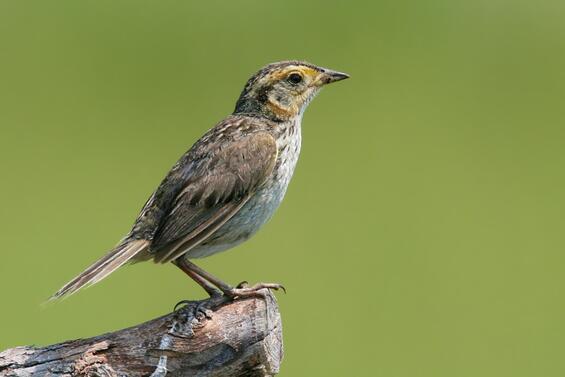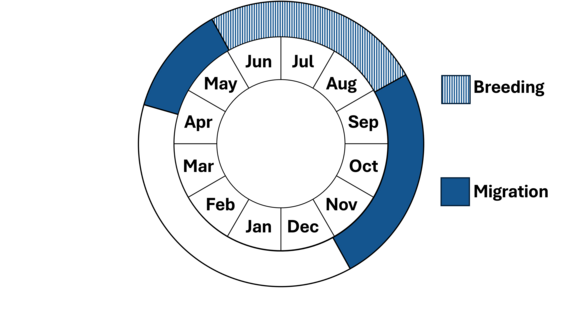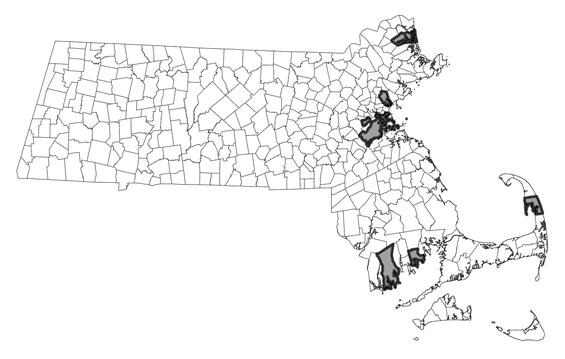- Scientific name: Ammospiza caudacuta
- Species of Greatest Conservation Need (MA State Wildlife Action Plan)
- Special Concern (MA Endangered Species Act)
Description

Saltmarsh sparrow
The saltmarsh sparrow is 13-15 cm (5-6 in) in lengthwith a sharp tail, streaked breast, and buffy-yellow facial pattern surrounding a gray ear patch. Its primary vocalization is a buzzing hiss, preceded or followed by several sharp notes: tuptup-sheeeeee. Juveniles appear similar to adults but have more overall buffy coloration through the breast and sides. This species is very similar to the more northerly nesting Nelson’s sparrow but can be distinguished by plumage with a deeper orange coloration in its face and more strongly streaked undersides and vocalizations are distinct. However, a hybridization zone for these two species exists in Massachusetts with resulting offspring showing intermediate plumages. Saltmarsh sparrow also can be confused with the larger and drabber seaside sparrow.
Life cycle and behavior

Phenology in Massachusetts. This is a simplification of the annual life cycle. Timing exhibited by individuals in a population varies, so adjacent life stages generally overlap each other at their starts and ends.
Saltmarsh sparrow arrive on their Massachusetts breeding grounds in May and begin nesting by late May or early June. It is a non-territorial species where males occupy large and typically overlapping home ranges. A pair bond is not formed, and females are solely responsible for nest building and caring for young. Nests from different females may be very close to one another. Their clutch size ranges from 3-6 eggs, incubation averages 11.8 days, and chicks fledge from the nest 9-10 days after hatching. Older nestlings (> 5 days) are known to climb up vegetation above the nest to evade flood waters. Saltmarsh sparrows rapidly re-nest following nest failure, and they are known to double brood throughout their range. Following nesting, adults and young remain in the vicinity and molt on the breeding grounds before initiating fall migration that begins in September and peaks in October. Migratory stopover and wintering habitat is also salt marsh.

Population status
The naturally small global population of this species has been experiencing a 9% annual population decline since the 1990s, and the population is in jeopardy of collapsing within 50 years. The saltmarsh sparrow is listed as endangered by the International Union for the Conservation of Nature, and its status is being reviewed by USFWS for possible listing under the federal Endangered Species Act. Currently, the saltmarsh sparrow population has not undergone as drastic of a population decline in Massachusetts, and the species is listed as Special Concern under the Massachusetts Endangered Species Act. Breeding saltmarsh sparrows in Massachusetts are restricted to coastal salt marshes, where they may be locally abundant. The Massachusetts Breeding Bird Atlas 2 Project (2007-2011) confirmed breeding in 41 of 1,037 (4.0%) survey blocks and reported probable breeding in 13 blocks (1.3%) and possible breeding in 23 blocks (2.2%; Walsh and Petersen 2013). Currently, this species can be locally found in the Great Marsh and within suitable habitat from Boston, throughout Cape Cod and Islands, and along Buzzards Bay.
Distribution and abundance
The saltmarsh sparrow is a short-distance migrant and obligate tidal saltmarsh specialist that is the only species of breeding bird endemic to the salt marshes of the Northeast. In fact, it is the only species completely restricted to our Atlantic coast and does not exist anywhere else on the planet. Their breeding range includes saltmarshes from Virginia to Maine, and they spend winters in similar habitat from Maryland to Florida.

Distribution in Massachusetts.
1999-2024
Based on records in the Natural Heritage Database.
Habitat
The saltmarsh sparrow inhabits coastal salt marshes dominated by salt meadow cordgrass (Spartina patens) and saltwater cordgrass (S. alterniflora). Nests are placed on or near the ground, just above high tide levels, and in salt meadow cordgrass in the upper (i.e., drier) areas of salt marsh, often referred to as high marsh. Many of these habitats have been degraded due to past land use practices (that have changed the hydrology of the system) and rising ocean levels and increasing storm intensity.
Healthy habitats are vital for supporting native wildlife and plants. Explore habitats and learn about conservation and restoration in Massachusetts.
Threats
Sea-level rise exacerbating high tide flooding is the primary factor reducing reproductive success and threatens long-term persistence of this species in New England and throughout its range. Predation pressure has been identified as a major threat in the mid-Atlantic region, and that also may become an issue in Massachusetts. Additionally, any activities that would destroy, fragment, or otherwise degrade salt marsh habitat, including dredging, ditching, filling, diking, or oil spills, may be threats to saltmarsh sparrows.
An additional threat to the species is collisions with buildings and other structures, as approximately 1 billion birds in the United States are estimated to die annually from building collisions. A high percentage of these collisions occur during the migratory periods when birds fly long distances between their wintering and breeding grounds. Light pollution exacerbates this threat for nocturnal migrants as it can disrupt their navigational capabilities and lure them into urban areas, increasing the risk of collisions or exhaustion from circling lit structures or areas.
Conservation
The conservation of the saltmarsh sparrow relies on the management of salt marsh habitat that restores the tidal flow and natural hydrology of the system returning the sediment supply to the marsh and allowing for marsh accretion. In marshes with current tidal restrictions in place that have caused marsh subsidence, restoring the tidal flow may need to be done gradually. In areas where the current salt marsh habitat does not abut development, there may be opportunities to assist marsh migration to create habitat for the species. More extreme efforts to conserve the species may include creating floating marsh islands in hopes the birds use them for nesting and captive breeding programs.
Bird collision mortalities can be minimized by making glass more visible to birds. This includes using bird-safe glass in new construction and retrofitting existing glass (e.g., screens, window decals) to make it bird-friendly and reducing artificial lighting around buildings (e.g., Lights Out Programs, utilizing down shielding lights) that attract birds during their nocturnal migration.
References
Greenlaw, J. S., C. S. Elphick, W. Post, and J. D. Rising (2020). Saltmarsh Sparrow (Ammospiza caudacuta), version 1.0. In Birds of the World (P. G. Rodewald, Editor). Cornell Lab of Ornithology, Ithaca, NY, USA. https://doi.org/10.2173/bow.sstspa.01
Hartley, M.J. and A.J. Weldon, eds. 2020. Saltmarsh Sparrow Conservation Plan. Atlantic Coast Joint Venture, acjv.org/documents/SALS_plan_final.pdf
Roberts, S. G., R. A. Longenecker, M. A. Etterson, K. J. Ruskin, C. S. Elphick, B. J. Olsen, and W. G. Shriver. 2017. Factors that influence vital rates of Seaside and Saltmarsh sparrows in coastal New Jersey, USA. Journal of Field Ornithology 88 (2):115-131.
Staudinger, M.D., A.V. Karmalkar, K. Terwilliger, K. Burgio, A. Lubeck, H. Higgins, T. Rice, T.L. Morelli, A. D'Amato. 2024. A regional synthesis of climate data to inform the 2025 State Wildlife Action Plans in the Northeast U.S. DOI Northeast Climate Adaptation Science Center Cooperator Report. 406 p. https://doi.org/10.21429/t352-9q86
Walsh, J., and W. Petersen, editors. 2013. The Massachusetts Breeding Bird Atlas 2. Massachusetts Audubon Society. Scott & Nix, Inc. New York City, NY.
Contact
| Date published: | April 2, 2025 |
|---|